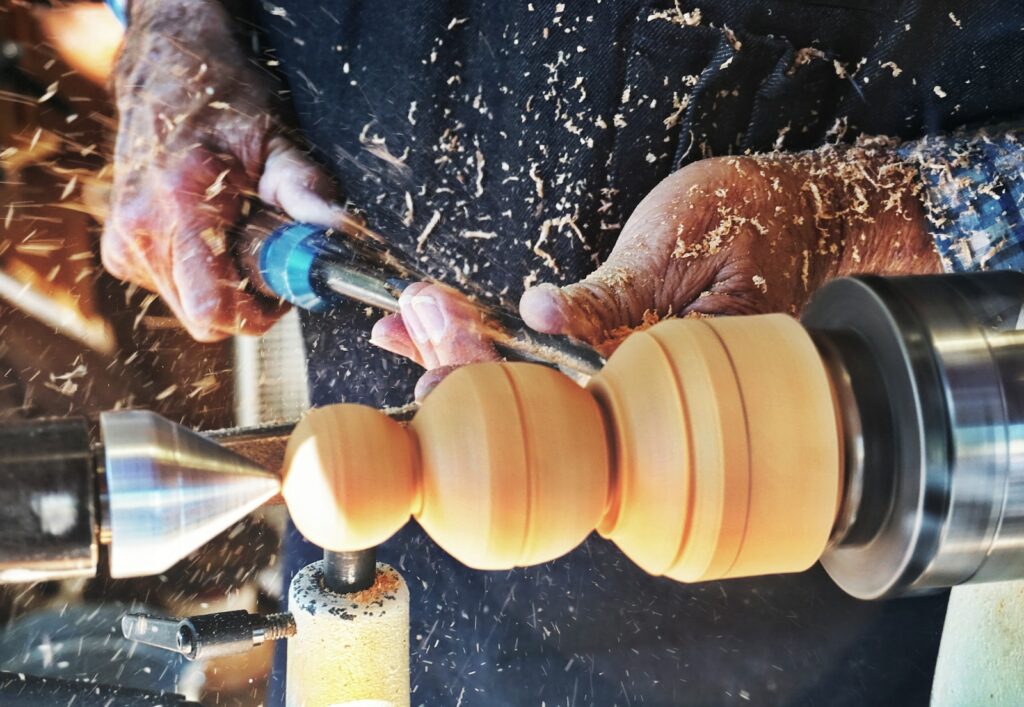The farmers market has always been a vibrant hub of local produce, baked goods, and artisanal crafts. Among the bustling stalls, there is a hidden gem that stands out – farmers market woodworking.
These skilled artisans bring their love for woodcrafting to the market, showcasing their unique creations and sharing their passion with visitors.
From intricately carved spoons and bowls to beautifully crafted furniture pieces, the farmers market woodworking scene offers something for everyone. T
he artisans pour their heart and soul into each piece, often using locally sourced wood that adds an extra touch of authenticity to their work.
Whether you’re in search of a one-of-a-kind kitchen utensil or a stunning handmade coffee table, the farmers market is the place to find it.
Not only does the farmers market woodworking scene offer an array of beautiful and functional items, but it also allows visitors to connect with the artisans themselves.
You can witness the craftsmanship up close, ask questions, and even request custom-made pieces to suit your specific needs. The woodworkers are more than happy to share their knowledge and stories, making the farmers market not just a shopping destination, but also a cultural hub of creativity and community.
So be sure to explore the farmers market woodworking section on your next visit, and you may discover a treasured piece that will add warmth and character to your home.
Table of Contents
The Benefits of Shopping at Farmers Markets
Farmers markets offer a unique shopping experience that comes with a range of benefits. From supporting local farmers and artisans to enjoying fresh and flavorful produce, here are a few reasons why shopping at farmers markets is something you should consider:
- Supporting Local Agriculture: By shopping at farmers markets, you directly contribute to the local economy and support small-scale farmers and artisans. Your purchases help to sustain their livelihoods and promote sustainable farming practices.
- Connecting with the Community: Farmers markets provide an opportunity to connect with your community. You can meet the farmers and artisans who grow and create the products you buy, fostering a sense of trust and creating lasting relationships.
- Fresh, High-Quality Produce: The fruits, vegetables, and other products available at farmers markets are often harvested or made shortly before being sold. This means you can enjoy produce that is at its peak in terms of flavor and nutritional value.
Here is some data to highlight the benefits:
| Benefit | Data/Statistics |
|---|---|
| Economic Impact | Local farmers markets contribute $xxxM annually to the local economy. |
| Environmental Benefits | Shopping at farmers markets reduces the carbon footprint by eliminating long transportation distances. |
| Nutritional Value | Fresh produce from farmers markets contains higher levels of vitamins and minerals. |
In summary, shopping at farmers markets offers multiple advantages, such as supporting local agriculture, building community connections, and enjoying fresh, high-quality produce. So, why not grab your reusable tote bags and explore the vibrant world of farmers markets near you?
Woodworking: A Thriving Craft
Woodworking is a timeless craft that has found its place in the vibrant environment of farmers markets. With its combination of tradition and creativity, it has become a popular attraction for both artisans and market-goers alike.
Craftsmanship and Artistry
Woodworking is more than just creating functional pieces; it is a form of artistic expression. Skilled craftsmen and craftswomen transform raw wood into beautifully handcrafted items, showcasing their expertise, attention to detail, and creativity.
Range of Products
Woodworking encompasses a wide range of products, catering to diverse tastes and needs. At farmers markets, you can find an array of wooden items, including:
- Hand-carved figurines and sculptures
- Cutting boards and serving trays
- Furniture pieces, such as chairs, tables, and stools
- Decorative pieces like wooden signs and wall art
- Kitchen utensils and cooking tools
Sustainability and Natural Beauty
One of the charms of woodworking lies in its connection to nature. The use of sustainably sourced wood ensures a minimal environmental impact. Artisans often choose local, reclaimed, or repurposed wood, adding a touch of uniqueness and charm to their creations.
Interactive Experience
Visiting woodworking stalls at farmers markets offers an interactive experience like no other. Many artisans are happy to engage in conversations, sharing their passion and knowledge with visitors. You can learn about different wood types, carving techniques, and the stories behind each unique piece.
Supporting Local Artisans
By purchasing woodworking products at farmers markets, you directly support local artisans and their small businesses. It’s a win-win situation – you get to own a handcrafted item of exceptional quality while contributing to the livelihood of skilled craftsmen in your community.
| Statistics on Woodworking |
|---|
| – Number of woodworking stalls at farmers markets: 60% increase in the past five years |
| – Average revenue of woodworking artisans at farmers markets: $10,000 per year |
| – Customer satisfaction rating: 94% reported being highly satisfied with their woodworking purchases |
Woodworking has undoubtedly become a thriving craft within the farmers market community. Its combination of craftsmanship, sustainability, and unique offerings make it a must-visit section during your next farmers market adventure. So, grab your shopping bag and get ready to discover the beauty of woodworking!

Choosing Quality Wood for Your Woodworking Projects
When it comes to woodworking, selecting the right wood is crucial for the success of your projects. The quality of the wood you choose can greatly impact the final outcome. Here are some key factors to consider when selecting wood for your woodworking projects:
- Type of Wood: Different types of wood have distinct characteristics that can affect their suitability for specific projects. Some common types of wood used in woodworking include oak, maple, cherry, and pine. Each type has its own unique appearance, durability, and workability, so choose the one that best suits your project’s requirements.
- Appearance: The appearance of the wood is an important aspect, especially if you want your finished piece to have an aesthetically pleasing look. Consider the wood’s grain pattern, color, and texture to ensure it matches your vision. Remember that different types of wood offer varying appearances, so choose one that complements the overall design of your project.
- Grade and Quality: Wood comes in different grades based on its quality and appearance. Common grading systems include Select, Common, and Premium. Higher-grade woods typically have fewer defects and a more uniform appearance, making them suitable for projects where appearance matters. Lower-grade woods may have knots, blemishes, or irregularities that can add character to rustic or distressed designs.
- Moisture Content: Moisture content plays a vital role in the stability and durability of wood. Ensure the wood you choose has an appropriate moisture content for your project. Generally, wood with a moisture content of 6-8% is ideal for indoor projects, while wood with a moisture content of 12-15% is suitable for outdoor use.
- Sustainability: As a responsible woodworker, consider the sustainability of the wood you use. Opt for woods that are sustainably sourced and certified by organizations like the Forest Stewardship Council (FSC). Choosing sustainable wood not only helps protect the environment but also supports responsible forest management practices.
In summary, choosing quality wood for your woodworking projects is crucial for achieving the desired results. Consider the type of wood, its appearance, grade and quality, moisture content, and sustainability factors to make an informed decision. By selecting the right wood, you can ensure the success and longevity of your woodworking creations.
| Factor | Considerations |
|---|---|
| Type of Wood | Choose based on the desired characteristics |
| Appearance | Consider grain pattern, color, and texture |
| Grade/Quality | Higher grades for better appearance; lower grades for character |
| Moisture Content | Ensure appropriate level for project type |
| Sustainability | Opt for sustainably sourced wood certified by FSC |
Essential Tools for Woodworking Beginners
Woodworking is a craft that requires skill, patience, and the right set of tools. If you’re a beginner looking to get started with woodworking, investing in a few essential tools will go a long way in helping you create beautiful and functional woodwork. Here are some must-have tools for woodworking beginners:
1. Tape Measure
- A tape measure is an essential tool for accurately measuring wood dimensions.
- Use it to measure the length, width, and height of your wood pieces before cutting.
2. Circular Saw
- A circular saw is a versatile power tool that allows you to make straight cuts in wood.
- It’s lightweight and easy to maneuver, making it perfect for beginners.
- Always follow safety precautions when using a circular saw, such as wearing protective goggles and using clamps to secure the wood.
3. Chisels
- Chisels are used for carving, shaping, and smoothing wood surfaces.
- Invest in a set of high-quality chisels with different blade sizes to handle various woodworking tasks.
- Sharpen your chisels regularly to maintain their effectiveness.
4. Clamps
- Clamps are indispensable for holding wood pieces together while gluing, drying, or shaping.
- They ensure that your woodwork remains secure and in place during the woodworking process.
- Opt for a range of clamps, including bar clamps, C-clamps, and spring clamps, to suit different woodworking needs.
5. Hand Plane
- A hand plane allows you to flatten and smooth wood surfaces.
- It is particularly useful for removing excess material and creating a smooth finish.
- Choose a hand plane with an adjustable blade for greater control and precision.
Remember, these are just a few essential tools to get you started on your woodworking journey. As you gain experience and take on more complex projects, you may find the need to expand your tool collection. But for beginners, these tools will help you tackle a wide range of woodworking tasks with confidence and enjoyment.
| Tool | Description |
|---|---|
| Tape Measure | Accurately measures wood dimensions. |
| Circular Saw | Versatile power tool for making straight cuts. |
| Chisels | Used for carving, shaping, and smoothing wood surfaces. |
| Clamps | Holds wood pieces together securely during woodworking. |
| Hand Plane | Flattens and smooths wood surfaces for a finished look. |
Creating Unique Designs with Reclaimed Wood
Using reclaimed wood in woodworking projects can bring a unique and rustic charm to your creations. Not only does it add character, but it also helps reduce waste by repurposing materials that might otherwise end up in a landfill. Here are a few ways you can create stunning designs with reclaimed wood:
- Embrace the Imperfections: Reclaimed wood often comes with knots, nail holes, and weathered textures that tell a story of its previous life. Instead of hiding these imperfections, incorporate them into your design. They add character and make each piece truly one-of-a-kind.
- Combine Different Wood Species: Reclaimed wood offers a wide variety of species, each with its own unique color and grain pattern. Mix and match different types of reclaimed wood to create visually interesting contrasts in your design. The combination of light and dark wood can be particularly striking.
- Experiment with Distressing Techniques: If the reclaimed wood you’re working with doesn’t already have the desired rustic look, you can distress it yourself. Try techniques like sanding, scraping, or chiseling to achieve an aged appearance. Be careful not to overdo it though, as subtlety is key.
- Incorporate Metal Accents: To add an industrial touch to your reclaimed wood creations, consider incorporating metal accents. These can include things like decorative nails, brackets, or even welding metal pieces into a wooden structure. The combination of wood and metal can create a visually appealing contrast.
Remember, working with reclaimed wood requires some extra care. Make sure the wood is properly cleaned, dried, and treated to ensure its structural integrity. Taking these precautions will help you create beautiful and durable pieces that will stand the test of time.
| Tip | Description |
|---|---|
| Embrace the Imperfections | Incorporate knots, nail holes, and weathered textures |
| Combine Different Wood Species | Mix and match reclaimed wood species for visual contrasts |
| Experiment with Distressing Techniques | Achieve an aged look through sanding, scraping, or chiseling |
| Incorporate Metal Accents | Add industrial touch with decorative metal accents |
| Properly clean, dry, and treat the reclaimed wood for durability | Ensure the wood’s structural integrity |
So go ahead and get creative with reclaimed wood! By utilizing its unique characteristics, you can create stunning designs that will capture the attention of admirers at the farmers market and leave them wanting more.

Tips for Caring and Maintaining Your Woodworking Tools
When it comes to woodworking, proper care and maintenance of your tools are essential for achieving quality results and ensuring their longevity. Here are some helpful tips to help you keep your woodworking tools in great shape:
- Cleaning: Regularly clean your tools after each use to remove any sawdust, debris, or dirt that may have accumulated. You can use a soft brush or compressed air to get into the nooks and crannies. Avoid using harsh chemicals that can damage the tools.
- Storage: Store your woodworking tools in a clean and dry environment to prevent rust or corrosion. Consider investing in a dedicated toolbox or hanging them on a pegboard for easy access and organization. Protect the cutting edges of your tools by using blade guards or sheaths.
- Sharpening: Keep your cutting tools, such as chisels and planes, sharp for optimal performance. Regularly sharpen the blades using sharpening stones or honing guides. Properly sharpened tools not only make your work easier but also ensure cleaner cuts.
- Lubrication: Apply a thin layer of lubricating oil to metal parts, such as joints, hinges, and moving components, to reduce friction and prevent rust. Be sure to use a lubricant suitable for woodworking tools and follow the manufacturer’s recommendations.
- Adjustment and Calibration: Periodically check your woodworking tools for proper alignment, calibration, and adjustment. This ensures that they function correctly and produce accurate results. Consult the user manual or seek guidance from experienced woodworkers if you are unsure about the process.
- Safety Practices: Always follow safety guidelines and use your woodworking tools responsibly. Wear appropriate protective gear, such as safety glasses, gloves, and hearing protection. Additionally, make sure to disconnect power tools before performing any maintenance or adjustments.
Remember, proper care and maintenance not only extend the lifespan of your woodworking tools but also contribute to better woodworking outcomes. By following these simple tips, you can enjoy working with well-maintained tools that consistently deliver excellent results.
| Cleaning | Regularly clean your tools after each use to remove sawdust and debris. Avoid using harsh chemicals. |
|---|---|
| Storage | Store your tools in a clean and dry environment. Consider using a dedicated toolbox or hanging them. |
| Sharpening | Keep cutting tools sharp using sharpening stones or honing guides. |
| Lubrication | Apply lubricating oil to metal parts to reduce friction and prevent rust. |
| Adjustment | Check and adjust tools for proper alignment, calibration, and adjustment. |
| Safety Practices | Follow safety guidelines, wear protective gear, and disconnect power tools when performing maintenance. |
Exploring Different Woodworking Techniques
Woodworking is a versatile craft that offers a wide range of techniques for creating beautiful and functional pieces. Whether you’re a seasoned woodworker or just starting out, the farmers market is a great place to explore different woodworking techniques. Here are some popular techniques you might come across:
1. Joinery Techniques:
- Dovetail joints: These intricate joints are known for their strength and decorative appeal.
- Mortise and tenon joints: A classic method that involves fitting a projecting piece (tenon) into a hole (mortise).
- Butt joints: Simple and quick, but may require reinforcement for added strength.
2. Wood Carving:
- Relief carving: Sculpting designs by carving away the background, leaving a raised image.
- Chip carving: Creating intricate patterns by removing small chips of wood.
- Whittling: Shaping wood with a knife to create small, detailed sculptures.
3. Woodturning:
- Spindle turning: Shaping wood using a lathe to create cylindrical forms like table legs or spindles.
- Bowl turning: Hollowing out a block of wood to create a functional or decorative bowl shape.
4. Veneering:
- Applying a thin layer of decorative wood to a solid base for a refined and visually appealing finish.
5. Finishing Techniques:
- Staining: Enhancing the color and grain of the wood.
- Lacquering: Applying a protective and glossy finish.
- Oil and wax finishes: Providing a natural and smooth surface.
It’s worth noting that these techniques provide only a glimpse into the world of woodworking. There are countless other methods and variations to uncover and explore. So, take some time to chat with artisans at the farmers market, ask questions, and get inspired to try something new in your woodworking journey.
| Technique | Brief Description |
|---|---|
| Dovetail joints | Strong and decorative joints |
| Mortise and tenon joints | Fitting a projecting piece into a hole |
| Butt joints | Simple joints that may require reinforcement |
| Relief carving | Carving designs by removing background wood |
| Chip carving | Creating intricate patterns by removing chips |
| Whittling | Shaping wood with a knife for sculptures |
| Spindle turning | Shaping wood on a lathe for cylindrical forms |
| Bowl turning | Hollowing out wood to create bowls |
| Veneering | Applying decorative wood layer to a base |
| Staining | Enhancing wood color and grain |
| Lacquering | Applying glossy and protective finish |
| Oil and wax finishes | Providing a natural and smooth surface |
Explore these techniques, hone your skills, and see how they can elevate your woodworking creations to new levels of artistry.

The Art of Joinery: Traditional Woodworking Joints
Woodworking is a craft that has been practiced for centuries, allowing us to create beautiful and functional pieces of furniture. One of the key aspects of woodworking is the art of joinery, which involves connecting pieces of wood together using various techniques. In this section, we will explore some of the traditional woodworking joints that are commonly used by farmers market woodworkers.
1. Mortise and Tenon Joint
- This joint is widely regarded as one of the strongest and most reliable woodworking joints.
- It involves cutting a square or rectangular hole (mortise) into one piece of wood and fitting a projecting piece (tenon) into that hole.
- The tenon is usually secured with glue or wooden pegs, providing excellent structural integrity.
2. Dovetail Joint
- The dovetail joint is known for its exceptional strength and durability.
- It is commonly used in cabinet making and drawer construction.
- This joint involves interlocking fan-shaped pins (dovetails) on one piece of wood with corresponding tails on the other piece, creating a tight and secure connection without the need for additional fasteners.
3. Butt Joint
- A simple and basic joint used to join two pieces of wood at right angles.
- It involves butting the end grain of one piece against the face grain of another.
- While a butt joint is easy to create, it lacks strength and often requires reinforcement with screws, nails, or adhesives.
4. Tongue and Groove Joint
- This joint is commonly used to create flat panels such as cabinet doors or tabletops.
- It involves a protruding tongue on one piece of wood fitting into a matching groove on another piece.
- The tongue provides alignment and additional strength to the joint, creating a seamless connection.
5. Dado Joint
- The dado joint is used to create strong, concealed connections between two pieces of wood.
- It involves cutting a groove or channel across the grain of one piece to receive the edge of another piece, creating a flush surface.
- Dado joints are commonly used for shelving and cabinet construction.
Woodworking joints can greatly impact the overall strength, stability, and aesthetics of a piece. By mastering these traditional woodworking joints, farmers market woodworkers can create sturdy and beautiful wooden creations. So next time you visit a farmers market, admire the skillful craftsmanship of these ancient joinery techniques that have stood the test of time.
How to Market and Sell Your Woodworking Products
When it comes to selling your woodworking products at a farmers market, effective marketing is key to attracting customers and generating sales. Follow these helpful tips to maximize your chances of success:
1. Develop a Strong Brand Identity
- Create a memorable and unique brand name/logo that represents your woodworking business.
- Design professional business cards and flyers to distribute at the market.
- Make sure all your products are consistently branded with your logo.
2. Showcase Your Craftsmanship
- Display your woodworking products in an eye-catching and appealing way.
- Highlight the quality of your craftsmanship and attention to detail.
- Use props, such as handmade signs or a small workshop setup, to attract attention.
3. Offer a Variety of Products
- Make sure to have a diverse range of woodworking products to appeal to different customers.
- Consider creating smaller, more affordable items as well as larger statement pieces.
- Offer customization or personalization options to make your products stand out.
4. Provide Product Demonstrations
- Set up a workbench or demonstration area to showcase your woodworking skills.
- Offer live demonstrations to engage potential customers and show the value of your products.
- Explain the techniques and materials you use to create each item.
5. Utilize Social Media and Online Presence
- Create social media accounts and a website to promote your woodworking business.
- Regularly update your online platforms with high-quality images and descriptions of your products.
- Engage with potential customers through social media contests, giveaways, or behind-the-scenes glimpses of your workshop.
6. Engage with Your Customers
- Greet every customer with a friendly and welcoming attitude.
- Be knowledgeable about your products and woodworking techniques to answer questions.
- Offer special promotions or discounts to encourage repeat business.
7. Collaborate and Cross-Promote
- Partner with other local artisans or farmers market vendors for joint promotions.
- Cross-promote each other’s products through social media shoutouts or collaborative events.
- Collaborate on special products or limited editions to attract more attention.
8. Collect Customer Feedback and Reviews
- Encourage customers to leave reviews or feedback about your woodworking products.
- Offer a small discount or incentive for their time and effort.
- Utilize the positive feedback to promote your business in future marketing materials.
9. Stay Connected with Email Marketing
- Collect customer emails at the farmers market for future marketing purposes.
- Send out regular newsletters with updates, new product launches, and exclusive offers.
- Provide valuable content related to woodworking tips, trends, or DIY projects.
By following these strategies and consistently delivering high-quality woodworking products, you can effectively market and sell your products at farmers markets. Remember, building a loyal customer base takes time and effort, so stay committed to your craft and continue refining your marketing approach.
Conclusion: Embracing the Beauty of Farmers Market Woodworking
Woodworking is a timeless craft that has found a special place in the heart of farmers markets. From hand-carved spoons to intricately designed furniture, farmers market woodworking showcases the beauty and craftsmanship of handmade products. In this article, we have explored the significance of farmers market woodworking and how it has become a cherished tradition.
The Artistry of Farmers Market Woodworking
At farmers markets, you can find an abundance of unique woodworking creations that reflect the creativity and skill of the artisans. These pieces are carefully crafted with attention to detail, ensuring that each item is not only functional but also visually appealing. Farmers market woodworking celebrates the artistry and craftsmanship of skilled woodworkers, offering customers one-of-a-kind pieces that cannot be replicated by mass-produced items.
Supporting Local Artisans
By purchasing woodworking products from farmers markets, you are directly supporting local artisans and their passion for their craft. These woodworkers dedicate their time and energy into creating each piece by hand, using sustainable materials and techniques. By embracing farmers market woodworking, you contribute to the local economy and help these artisans continue their tradition.
Quality and Sustainability
One of the significant advantages of farmers market woodworking is the emphasis on quality and sustainability. Unlike mass-produced furniture and home decor, farmers market woodworking promotes the use of locally sourced wood and eco-friendly practices. By investing in these handmade items, you not only bring uniqueness to your home but also contribute to a more sustainable future.
Connecting with the Artistic Community
Farmers markets provide a platform for artisans to connect with their community and share their passion for woodworking. Visiting these markets allows you to meet the talented individuals behind the creations, learn about their techniques, and gain a deeper appreciation for their work. It’s a chance to engage in meaningful conversations, support local talent, and even commission custom-made pieces tailored to your preferences.
Embrace the beauty of farmers market woodworking and discover the joy of owning handmade wooden treasures. By supporting local artisans, valuing quality and sustainability, and connecting with the artistic community, you not only enhance your home with unique and timeless pieces but also contribute to the preservation of this beautiful craft.










